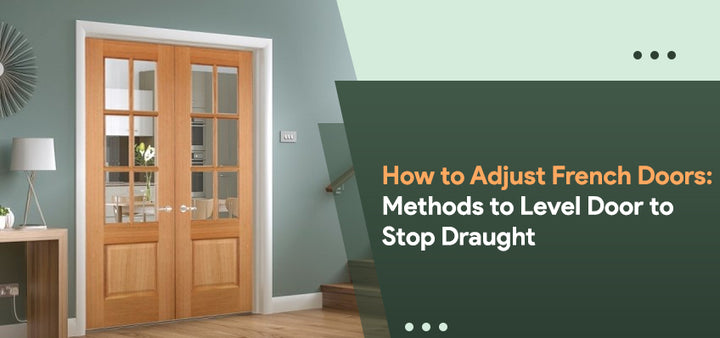How To Adjust French Doors: 4 Adjustment Methods
METHOD 1: Diagonal Adjustment
A French door frame needs sharp precision when it gets carved. A common issue with French doors is that the leaf of the door collides with the frame. To fix this issue, you will need to adjust your door diagonally. In such a case, follow these steps to correct the jagged door:
STEP 1: Check Distance Between French Door and Frame
Before you attempt to make an adjustment, you need to measure the space between the French door and the frame. This can easily be done using an inch tape or a yardstick.
STEP 2: Remove Plastic Cover and Bearings
The plastic covering on bearings may hinder your door from getting shut. Remove the plastic sheath from the corner bearings from the lower hinge.
STEP 3: Adjust the Screw
Adjusting French doors becomes easier at this point. The corner bearings are equipped with adjusting screws. You can turn it clockwise if you wish to raise the door leaf and anti-clockwise if you need to lower it.
METHOD 2: Parallel Adjustment of Sides and Height
Is your French door bumping and jamming the sides of your door frame? If so, you will need to adjust it parallelly. Parallel adjustment of the sides and height requires you to correct the upper stay bearings in the top corners of the door. Follow these below steps to adjust your French door:
STEP 1: Adjustment of Sides
To adjust the sides, the leaf of the door needs to be corrected horizontally or parallel to the ground. Adjusting the screws in the bearings will move the door accordingly. You will need to turn the screws on both the bearings (stay and corner) inversely.
To adjust, turn the screw in the stay bearing clockwise and the corner bearing anti-clockwise. Working in the opposite direction will undo the previous adjustment.
STEP 2: Adjustment of Height
Wondering how to raise French doors the right way? With the adjusted door height, you can thermally shield your house during the winter months. You can achieve this by parallelizing the door leaf to the sides of the frame.
Firstly, you will need to check the gap between the door and the doorframe. Then take off the plastic wrap from the corner bearing and adjust the screw to make the door parallel to the frame.
METHOD 3: Contact Pressure Adjustment
Adjusting contact pressure is necessary for your French doors to sit nice and flush securely. All you’ll need to do this is a few basic tools.
STEP 1: Locate Locking Pins
The first step is to locate the locking pins. Although these pins are typically found on the side of the handle, some safety doors might have them on the side of the hinge.
STEP 2: Pull Out The Pins and Adjust Contact Pressure
Turning these pins clockwise will increase the contact pressure, whereas turning them anti-clockwise will loosen it and lower the pressure.
STEP 3: Check Adjustment Pressure
The key to getting your French doors to sit just right is to get these pins turned to just the right amount of tightness.
Tightening it too much will prevent the door from opening and closing smoothly and damage the sealing between the doors. Leaving it too loose is just as bad as it can affect the thermal insulation your doors offer. You’ll have to work with it until you find the sweet spot.
METHOD 4: Adjusting Hinge
Hinges play a major role in determining how securely your French doors are set. The tightness of your hinges can make the difference between a nice, smooth and satisfying lock. Here’s how you can adjust your French door’s hinges without needing to call a professional:
STEP 1: Tighten All Screws With a Screwdriver
The first step is to check if all the screws on your hinges are tight. Most French doors use hinges with flat head screws, but some might need a Philips-head screwdriver. Once you have your tools, you’re ready to start adjusting your French door’s hinges.
Remember, screws tighten when turned clockwise and loosen when turned anti-clockwise. Make sure not to tighten them too much to avoid stripping the thread.
STEP 2: Check Gap Between Doors
Once you feel the hinge-screws are adequately tight, check for any potential gaps between the doors and the frame. Ideally, your doors should sit flush with each other and the ground while still being able to open and close them smoothly to maximize the thermal insulation. Ensure that the gap is even for the entire height of the doors.
STEP 3: Adjust Positioning Screws If Present
Some hinges might have positioning screws located in the centre of the hinge plates. If your door has these, you’ll need a hex wrench to adjust it.
If your door sags to the bottom, tighten the positioning screws of the top and middle hinges. Adjust the bottom screws if it sticks at the bottom. Turn the screws by half a turn each until the fit is just right.
STEP 4: Use Longer Screws If The Gap Is Large
Sometimes, the screws between the door and the frame can be pretty large, and tightening the screws might not seem to help much. In such cases, unscrew each screw and replace them with wood screws that are longer – ideally around 2-3 inches long.
Conclusion
French doors are a great addition to any home, with large glass panes letting plenty of light in and connecting you with the beautiful outdoors. However, it takes a little maintenance now and then to keep them looking and feeling as best as possible.
Adjusting your French doors every so often will ensure that they’re keeping the sound out and the heat in. With the above methods, you can make sure you’re getting the most out of your French doors!
